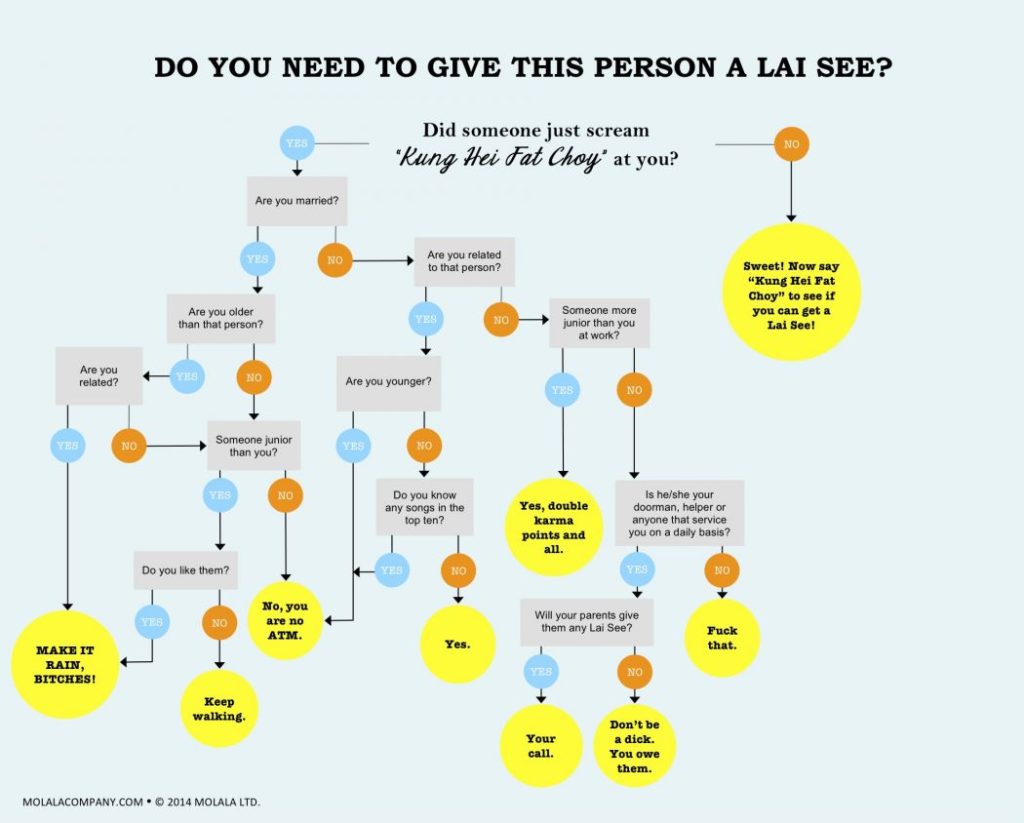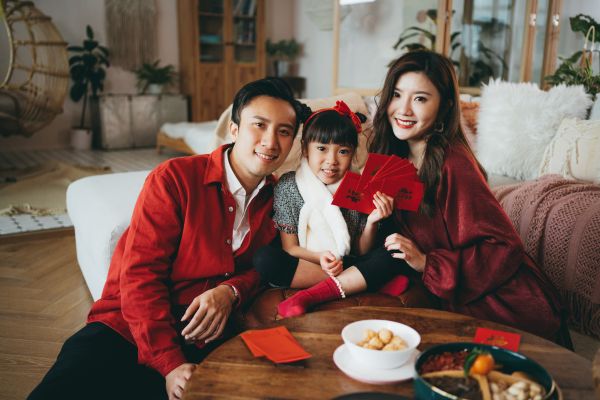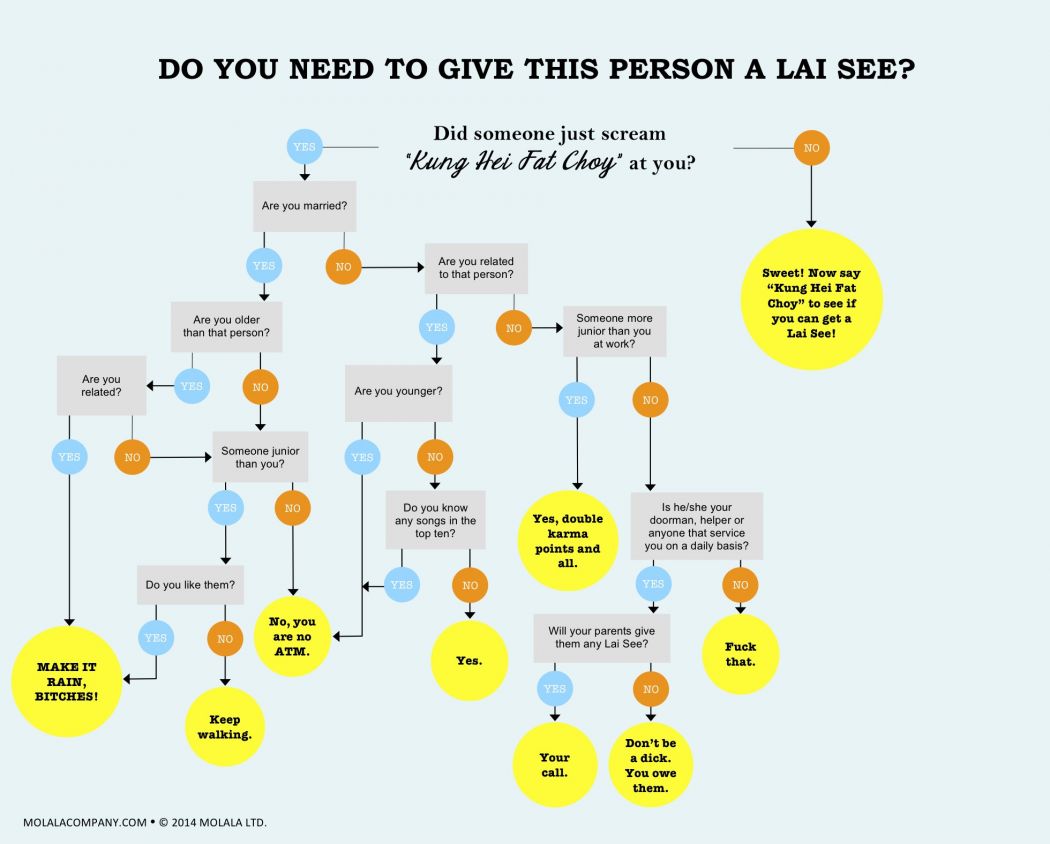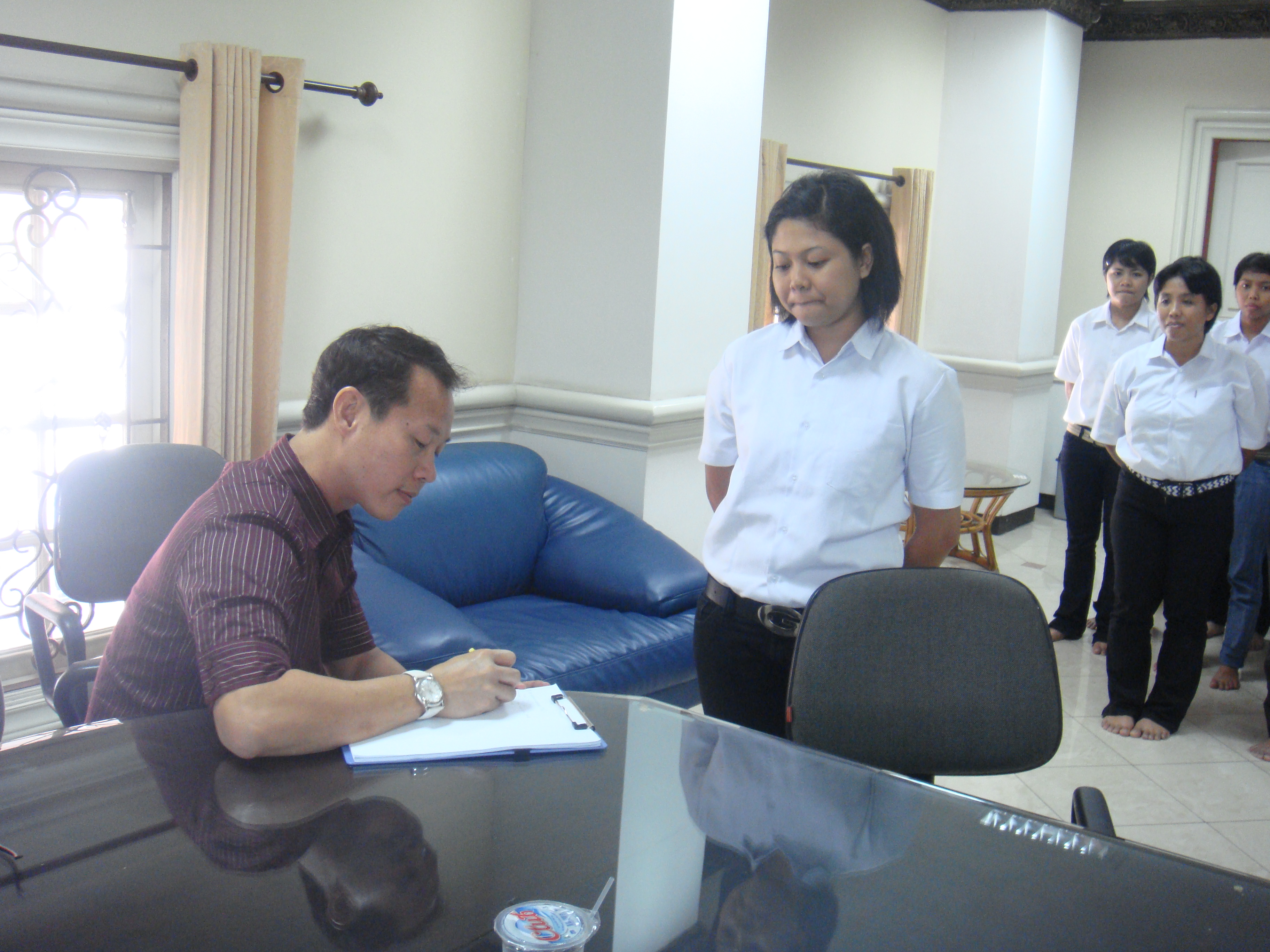Not sure whether you need to fill that red packet with crisp new bills? Here’s a guide from Molala to help you.

Cultural beliefs and superstitions associated with Lai See
The historical origins of Lai See can be traced back to ancient China, with its roots intertwined in both folklore and cultural practices. The tradition of giving monetary gifts during festive occasions predates the term “Lai See” itself.
One legend associated with the origin of Lai See revolves around a mythical creature called “Sui,” which was believed to appear on New Year’s Eve. It was said that the Sui would terrorize villagers and children, but it had an aversion to the color red and loud noises. Therefore, people started using red envelopes and filling them with money to protect against Sui’s evil spirits.
Another historical influence on giving Lai See is the “Ya Sui Qian,” meaning “suppressing age money.” In ancient times, evil spirits were believed to cause misfortune and illness during the transition from one year to the next. To ward off these spirits and ensure a prosperous year, people would offer money in red envelopes to children and younger family members. This act was believed to bring blessings, good luck, and longevity.
Over time, the tradition of giving monetary gifts during special occasions, including Chinese New Year, became more widespread. Giving Lai See became a means of warding off evil spirits and bringing good fortune and symbolized the exchange of blessings, well-wishes, and the passing on of wealth and prosperity.
While the precise historical origins of Lai See may have evolved and adapted over the centuries, the tradition remains integral to Chinese culture, deeply rooted in auspicious beliefs, community bonds, and celebrating important festivals like Chinese New Year.
Lai See envelopes are symbolic in Chinese culture, especially during festive occasions like Chinese New Year. The symbolism associated with Lai See encompasses various aspects, reflecting blessings, good fortune, and cultural beliefs. Here are some key symbolic meanings behind Lai See:
Prosperity and abundance: Lai See represents prosperity and abundance. The act of giving money in Lai See envelopes symbolizes the sharing of wealth and wishes for financial well-being in the coming year. It embodies the belief that generosity and kindness will attract prosperity and abundance into the lives of both the giver and the recipient.
Good Luck and Blessings: Lai See is believed to bring good luck and blessings to the recipient. The color red, which is traditionally associated with Lai See envelopes, symbolizes good fortune, happiness, and vitality in Chinese culture. By giving red envelopes, it is believed that one can bestow blessings and positive energy upon the recipient, fostering a year filled with good luck and favorable outcomes.
Auspicious Symbols: Lai See envelopes often feature auspicious symbols and phrases. These symbols can include images of dragons, phoenixes, Chinese zodiac animals, or other traditional motifs associated with luck, prosperity, and protection. The presence of these symbols on the envelopes enhances their symbolic significance and reinforces the well-wishes and positive intentions behind the gift.
Strengthening Relationships: Lai See plays a role in fostering and maintaining relationships. It represents a gesture of goodwill and shows respect for social and familial connections. By giving and receiving Lai See, individuals engage in reciprocity, reinforcing bonds and promoting harmony within the community.
Passing on Traditions and Wisdom: Lai See also symbolizes the passing on of traditions and wisdom from older generations to younger ones. The elders giving Lai See to children and younger family members signifies the transmission of blessings, cultural values, and ancestral wisdom. It carries the hopes for a bright future and encourages younger generations to uphold and carry forward cultural traditions.
Preparation for Giving Lai See
Several crucial preparations must be taken before giving Lai See to guarantee that the red envelopes are ready to impart blessings and good fortune. First and foremost, choosing the appropriate envelopes is critical. Red envelopes represent joy and good fortune and are usually used for Lai See.
They can be bought or manufactured by hand, with complex designs and fortunate motifs. Next, obtaining new and crisp banknotes is critical, as old or ripped money is considered unlucky. Using fresh bills to represent a new beginning and abundance is common. Adding auspicious symbols or phrases to Lai See envelopes provides a meaningful touch. Chinese characters denoting riches, longevity, or happiness can be included.

Choosing the right envelopes
Choosing the right envelopes is essential to preparing for giving Lai See. Traditionally, red envelopes are used for Lai See as red symbolizes luck, joy, and prosperity in Chinese culture. When selecting envelopes, choosing ones that are vibrant and eye-catching is ideal.
The envelopes can be made of paper or fabric, with various designs available, ranging from traditional patterns to modern interpretations. Some may feature auspicious symbols like dragons, phoenixes, or Chinese characters representing good fortune.
It is important to ensure that the envelopes are in good condition, without any tears or damage, as this reflects the care and respect put into the gesture of giving Lai See. Ultimately, the choice of envelopes should evoke a sense of celebration and convey the blessings and good wishes associated with the tradition.
Obtaining new, crisp banknotes for Lai See
In Hong Kong, obtaining new and crisp banknotes for Lai See is essential to the tradition. Therefore, it’s not surprising to notice a surge in demand for such notes during Chinese New Year. Here are some tips for acquiring banknotes for Lai See.
- Visit banks: One of the standard methods is to visit local banks in Hong Kong. Most banks offer services where you can exchange old banknotes for new ones. Check with your bank about their availability and any specific guidelines or requirements.
- Currency exchange counters: Currency exchange counters at airports or major commercial areas may also provide new banknotes for Lai See. Remember that fees or charges may be associated with exchanging currency at these locations.
- Special Lai See banknote packs: During the Chinese New Year season, some banks and financial institutions in Hong Kong offer special Lai See banknote packs. These packs contain new and crisp banknotes of different denominations, conveniently packaged for Lai See purposes. Keep an eye out for announcements from banks or inquire directly at branches for these offerings.
- Early preparation: It is advisable to plan and obtain new banknotes well before the Chinese New Year period. As the festival approaches, demand for new banknotes increases, and obtaining them may become more challenging.
Remember, it is customary in Hong Kong to give Lai See in even denominations, such as HK$20, HK$50, HK$100, or higher, to symbolize good luck and prosperity. Proper handling and storage of the banknotes is essential to keep them crisp and presentable until they are distributed in Lai See envelopes.
Personalizing Lai See envelopes with auspicious symbols or phrases
Personalizing Lai See envelopes with auspicious symbols or words is a cherished tradition that adds meaning and thoughtfulness to the gesture. Here are some practices specific to Hong Kong for personalizing Lai See envelopes:
- Chinese calligraphy: Hong Kong is known for its rich heritage of calligraphy. Personalizing Lai See envelopes with beautifully written Chinese characters can be a meaningful way to add an artistic touch. Skilled calligraphers can be commissioned to write auspicious phrases or wishes, infusing the envelopes with an elegant and traditional aesthetic.
- Symbolic patterns: Hong Kong-style Lai See envelopes often feature intricate patterns and designs with symbolic meanings. Common symbols include the Chinese knot, which represents unity and good luck, or the double happiness character (囍), symbolizing marital bliss. Incorporating these patterns on the envelopes adds a touch of cultural significance and positive energy.
- Zodiac animals: Hong Kongers often personalize Lai See envelopes by incorporating the zodiac animal of the current year. The animal is prominently displayed on the envelope, representing the recipient’s zodiac sign and invoking good fortune associated with that animal for the year. It adds a personalized and relevant element to the Lai See gift.
- Lucky colors and gold foil: In Hong Kong, red is the traditional for Lai See envelopes, symbolizing luck and happiness. Gold foil accents are commonly used to enhance the envelopes’ auspiciousness and make them visually appealing. The combination of red and gold is believed to bring prosperity and wealth, making the envelopes even more significant.
Etiquette and Customs of Giving Lai See
Etiquette and customs are essential in giving Lai See in Hong Kong.
Proper timing and protocol for giving Lai See
- Chinese New Year Period: Chinese New Year is the most common occasion for giving Lai See in Hong Kong. The dates of Chinese New Year vary each year, based on the lunar calendar. It typically falls between late January and mid-February. During this period, it is customary to prepare and distribute Lai See to family members, friends, colleagues, and those who provide services, such as domestic helpers or building staff.
- The First Day of Chinese New Year: The first day is considered the most auspicious time to give and receive Lai See. The blessings shared on this day are believed to set the tone for the entire year. Many people visit their elders and exchange Lai See with them as a sign of respect and well-wishes.
- Proper etiquette: When giving Lai See, it is important to present the envelopes with both hands as a sign of respect. The giver should offer words of blessings and good wishes to the recipient. Similarly, when receiving Lai See, it is polite to accept the envelope with both hands and express gratitude.
- Order of priority: Regarding Lai See distribution in Hong Kong, there is a conventional order of priority. Lai See is traditionally given to elders and senior family members first, followed by married couples, children, and younger relatives. Friends and coworkers are frequently included as well. This arrangement highlights the importance of seniority and familial relationships.
- Lai See amount: The amount of money in Lai See envelopes is a personal choice, but there are general guidelines to consider. Giving Lai See in even denominations, such as HK$20, HK$50, HK$100, or higher, is customary, as odd numbers are associated with funerals and mourning. The amount given should be appropriate to the relationship and financial capability of the giver.
- Red envelopes: In Hong Kong, red envelopes are predominantly used for Lai See, as red symbolizes luck and prosperity. Using new and crisp banknotes inside the envelopes is considered auspicious and respectful. Torn or old banknotes are best avoided, as they may be seen as inauspicious.
Respectful gestures when presenting Lai See
Hold the Envelope with Both Hands: When presenting the Lai See envelope to the recipient, hold it with both hands. This gesture demonstrates respect and signifies the significance of the gift. Avoid giving it with just one hand or using a casual gesture.
- Bow or nod: Accompany the presentation of Lai See with a slight bow or nod of the head as a sign of deference. This gesture shows humility and acknowledges the recipient’s importance.
- Use polite language: While presenting Lai See, use courteous and respectful language. Address the recipient with appropriate honorifics or titles, such as “Uncle,” “Auntie,” or “Grandma.” Express your well wishes and blessings, such as “Wishing you a prosperous year ahead” or “May you be blessed with good health and happiness.”
- Maintain eye contact: When presenting Lai See, maintain eye contact with the recipient. This demonstrates sincerity and shows that you are fully engaged in the exchange. Avoid looking away or being distracted during the gesture.
- Speak softly: When conveying your blessings or well wishes, speak softly and respectfully. Avoid being loud or boisterous, as it may be considered disrespectful or inappropriate during this exchange.
- Respect personal space: When presenting Lai See, be mindful of personal space. Maintain an appropriate distance and avoid invading the recipient’s personal space. Respect boundaries and ensure a comfortable and respectful interaction.
- Consider cultural norms: Be aware of any specific cultural norms or customs followed by the recipient or within their community. Different regions or families may have variations in gestures or expectations. Pay attention to the recipient’s response and adapt accordingly.
How much money to give in a Lai See
The amount of money to give in Lai See is influenced by various factors, including cultural norms, personal relationships, and financial capability. While there are no fixed rules, here are some general guidelines to consider:
- Even denominations: Giving Lai See in even denominations is customary, such as HK$20, HK$50, HK$100, or higher. Even numbers are considered lucky in Chinese culture, representing balance and harmony.
- Avoid odd numbers: Odd numbers are traditionally associated with funerals and are considered inauspicious. It is best to avoid giving Lai See in odd denominations, such as HK$10 or HK$30.
- Consider relationship and age: The amount of money given in Lai See varies depending on the recipient’s relationship and age. Closer family members, such as parents or grandparents, may receive a larger sum than friends or acquaintances.
- Financial capability: Give an amount within your financial limits and comfort level. The monetary value is secondary to the gesture and goodwill behind the gift. Don’t give an amount that will put you in financial difficulty or hardship.
- Regional and cultural variations: Different areas or communities may have different customs regarding Lai See amount. It is beneficial to be aware of any unique practices practiced by the local community or the recipient’s ethnic background.
- Consider the setting: The setting in which Lai See is given may also influence the amount. For example, giving Lai See to children during festive celebrations may be smaller compared to giving Lai See to employees or service providers.
Recipients of Lai See and their relationship to the giver
The recipients of Lai See and their relationship to the giver can vary depending on individual customs and preferences. Here are some common recipients and their relationship to the giver:
- Family members: Lai See is often given to immediate and extended family members during Chinese New Year celebrations. This includes parents, grandparents, siblings, aunts, uncles, and cousins. The amount given may vary based on the closeness of the relationship and individual family traditions.
- Friends: Close friends, primarily single or younger ones, may also receive Lai See as a gesture of goodwill and friendship during Chinese New Year. The amount given to friends can be more flexible and may depend on the level of company and personal discretion.
- Children: During Chinese New Year, it is customary to give children Lai See. It’s a method of wishing them luck and prosperity. Lai See can be given to children as a token of love and care by parents, grandparents, and relatives. When compared to adults, youngsters are frequently given less.
- Employees and service providers: Employers or business owners can present Lai See to their staff as a thank you for their hard work and dedication. Lai See may also be given to service providers such as domestic workers, building staff, and others who provide consistent services throughout the year.
- Acquaintances and others: Lai See may also be given to acquaintances, neighbors, or individuals who have provided assistance or support during the year. This can include teachers, mentors, or community members. The amount given to acquaintances may be smaller and is often based on personal discretion.
Lai See and modern celebrations
Lai See practices have evolved and adapted, reflecting changes in society, culture, and how people celebrate Chinese New Year.
Changes in Lai See practices over time.
Modernization of Lai See: With the advent of technology, traditional paper Lai See envelopes have been replaced by digital alternatives. Virtual Lai See, sent through mobile apps or electronic transfers, has become increasingly popular, especially among younger generations. This allows for convenient and instantaneous gifting across long distances.
Inclusion of Non-Traditional Recipients: Traditionally, Lai See was awarded to family members, relatives, and close acquaintances, but there has been a shift toward including a wider variety of recipients. People increasingly offer Lai See to improve professional ties and express gratitude to colleagues, business partners, and acquaintances.
Personalized Lai See: Customizing Lai See envelopes with auspicious symbols, calligraphy, or zodiac animals is becoming increasingly popular. This personalization gives a special touch and allows recipients to express their creativity while instilling meaning and cultural value in the envelopes.
Alternative designs: Alongside the traditional red envelopes, a wide variety of Lai See designs are now available in the market. These designs range from contemporary and minimalist styles to those featuring popular cartoon characters or celebrities. This diversification caters to different preferences and allows for more creative expression.
Environmental considerations: In recent years, growing environmental consciousness has shifted toward more sustainable Lai See practices. This includes using eco-friendly envelope materials and opting for digital Lai See to reduce paper waste.
Financial considerations: While there are no hard and fast laws, the amount offered in Lai See has gradually increased. Inflation, growing living costs, and changes in societal norms all impact this. Personal financial factors, however, continue to play a considerable influence in choosing the amount given.
Cultural exchange: Lai See practices have been adopted and adapted in nations other than traditional Chinese communities due to globalization and greater cultural exchange. People from various ethnic backgrounds now give and receive Lai See, adopting their own customs and traditions.
Digitalization of Lai See and electronic red envelopes
The digitalization of Lai See and the emergence of electronic red envelopes have transformed the traditional practice, offering new ways to exchange blessings and good fortune. Here are some key aspects of the digitalization of Lai See:
Mobile Apps and E-Transfers: Various mobile applications and digital platforms now allow users to send virtual Lai See through e-transfers. These apps provide a convenient and instantaneous way to exchange red envelopes, regardless of geographical distance.
Customization and personalization: Digital Lai See platforms often offer options to personalize the experience. Users can select virtual envelope designs, add personalized messages, and even include multimedia elements such as photos or videos to enhance the personal touch.
Group gifting: Digital platforms enable group gifting, where multiple individuals can contribute to a single virtual red envelope. This feature is particularly useful for group celebrations or collective gifts, such as office parties or community events.
Social media integration: Some digital Lai See platforms integrate with popular social media platforms, allowing users to send and receive red envelopes within their social network. This enhances the sense of community and encourages participation among friends and followers.
Payment integration: Digital Lai See platforms frequently interact with several payment methods, making it simple to link bank accounts or digital wallets for seamless transactions. This provides a safe and effective way of sending and receiving digital red envelopes.
Gaming elements: Some digital Lai See platforms incorporate gaming features to add fun and excitement. This can include virtual games, lucky draws, or interactive experiences that engage recipients and enhance the overall enjoyment of receiving Lai See.
Lai See etiquette for Non-Chinese individuals
Understanding and appreciating Lai See customs is vital for non-Chinese people in Hong Kong who want to participate in local culture and show appreciation for traditions. Here are some pointers to keep in mind:
Learn about the significance, customs, and traditions related with Lai See. Learn about its cultural significance and its significance during Chinese New Year. This understanding will allow you to appreciate the exercise and participate courteously.
Observe how locals exchange Lai See during Chinese New Year. Take note of the gestures, timing, and conventions used by others. If you have any questions or are unsure about something, don’t be afraid to approach a competent person, such as a friend, coworker, or local guide.
Consider engaging in the ritual if invited to a Chinese New Year party where Lai See is exchanged. Prepare some red envelopes filled with new banknotes for Lai See. The gesture will be appreciated and demonstrate your respect for local customs.
Follow the etiquette and rituals outlined before while presenting or receiving Lai See. Use both hands to hold the envelope, use courteous language, and demonstrate respect with your motions and words. Remember to send your best wishes and blessings to the lucky receiver.
While there are no hard and fast regulations, remember the common quantities mentioned in Lai See. Consider the recipient’s relationship to you, age, and cultural norms. Avoid contributing odd amounts connected with funerals by aiming towards even denominations.
Be aware of any business regulations or procedures about Lai See exchanges if you are in a professional setting. Respect the workplace norms and expectations while yet taking part in the festivities. Maintaining professionalism and avoiding the appearance of favoritism is also vital.
Recognize and appreciate Lai See’s symbolic significance as a gesture of friendliness, blessings, and good fortune. Recognize its cultural importance to the Chinese community and approach it with humility and gratitude.
Appropriate occasions to give Lai See as an expat
Giving Lai See as a non-Chinese person in Hong Kong can be a meaningful expression of respect and cultural appreciation on certain occasions. During Chinese New Year celebrations, Lai See is traditionally exchanged among family, friends, and colleagues.
If you are invited to a Chinese New Year celebration or are celebrating with Chinese friends, preparing some Lai See envelopes with fresh banknotes and gifting them to your hosts or close friends will show your appreciation and respect for their customs.
Furthermore, if you have Chinese employees or service providers, such as housekeepers or construction workers, gifting Lai See as a token of thanks during Chinese New Year can generate goodwill and develop connections. It is critical to embrace these occasions honestly, knowing the cultural significance, and adhering to correct Lai See etiquette.
Conclusion
Lai See is important in Chinese culture, primarily on joyous occasions such as Chinese New Year. Giving red envelopes filled with money is a ritual that represents good luck, blessings, and wealth.
Giving Lai See is considered a goodwill gesture and is thought to bring both the giver and the recipient good fortune. Lai See envelopes are often crimson, as red represents good fortune and fights off evil spirits. The quantity of money given in Lai See varies depending on criteria such as the giver’s and recipient’s relationship, age, and cultural standards.
Giving Lai See is also related to customs and etiquette, such as delivering the envelope with both hands and using courteous language. With the advent of technology, Lai See traditions have expanded, allowing for virtual conversations and individualized experiences. Whatever changes occur, the core of Lai See remains anchored in spreading blessings and joy throughout joyful festivals.


